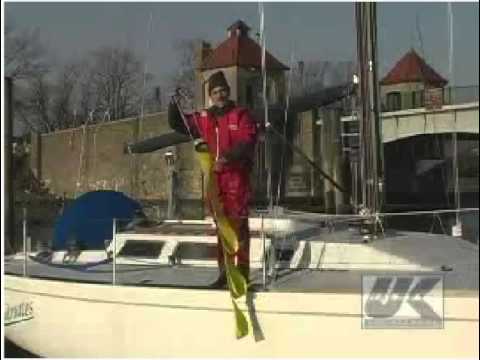
Man-Over-Board Recovery
The hardest part of recovering a crew overboard can be actually getting the person back onto the boat. Only fully-crewed boats can attempt to pull a person up over the side by bruit strength. Shown here are four strong midshipmen from the US Merchant Marine Academy at Kings Point working hard to pull the man-overboard back aboard. They struggle even though they have the advantage of rescuing a person in a survival suit, which does not gain weight when wet like foul weather gear. Even with a team of strong men pulling it take some time to get the guy aboard. Therefore you need to have some other methods to try.
If your boat has an open transom or a swim platform, try bringing the person up via the low opening. Don’t try this in any kind of waves, because the transom can come down on the person’s head as the boat pitches.
Another method that is taught is to lower a loop of line over the side where one end is secured to a cleat or something attached with a backing plate. The loose end of the line goes to a winch. Have the person step in the bight of the line and then winch the line tight, which will elevate the person high enough that they can climb aboard.
Deploying a boarding ladder is another option. Boat/US tested 20 ladders recently and liked the Sea Steps® from C-Level. It is made out of stiff webbing that is easy to stow, is light, does not scratch the boat and can be deployed anywhere that you can tie it on. I think throwing a loop over a winch is the easiest. To use it, put your feet in the loops and climb up. You’ll need to use some upper body strength to get started. A ladder is a big help to get aboard a boat with high topsides.
By far the most secure method is to hook a halyard to the person and then hoist him or her to the deck using a winch. If you use a Life Sling, you can clip the halyard the bridle without having to bend over the side of the boat to make the connection. If the person in the water is wearing an inflatable life vest, you can hook the halyard to the vest’s harness. Once the halyard is secured to the person in the water, they are attached to the boat and you are not depending on someone’s grip to keep hold of the person. Since most of the time you will be using a halyard that exits the front of the mast, like a spinnaker halyard, pull the person forward before winching them up to reduce chafe at the top of the mast.
Here is the clipping on process in slow motion in case you missed it the first time. I can’t stress enough how much better this method is since once the halyard is secured to the MOB. Once you have the halyard attached to the man overboard, they will not be able to drift away from the boat.


